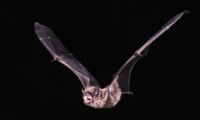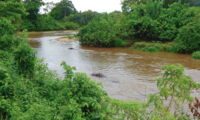The Leibniz-IZW regular publishes press releases on key findings and insights from its research and on events, awards or personalia. The press releases are distributed directly to journalists on our press release distribution mailing list. Press releases are also disseminated through the distribution services Informationsdienst Wissenschaft, AlphaGalileo and EurekAlert. Are you interested in receiving our press releases directly via e-mail? In this case please send us an email to presse@izw-berlin.de.
Current press releases
-a2vwtxq01qwpcmt.jpg)
City bats have a more varied diet than their rural relatives
Insectivorous bats such as the common noctule find less food in cities than in the countryside – yet their diet is more varied. This was demonstrated by a scientific team led by the Leibniz Institute for Zoo and Wildlife Research (Leibniz-IZW) in an article published in the journal “Landscape and Urban Planning”. Using genetic analyses of faecal samples, they showed that common noctules in Berlin consumed 55 per cent more insect species than their conspecifics in the surrounding rural regions. Also, urban bats consumed twice as many ‘pest’ insect species and six times as many ‘nuisance’ species such as mosquitoes than their rural counterparts.
Read more … City bats have a more varied diet than their rural relatives
_web-8v5hadj9fpz14h0.jpg)
Red squirrels adjust their diurnal activities very flexibly to humans, pets and wildlife in cities
Scientific investigations before and during the COVID-19 lockdown in Berlin in 2020 show that urban red squirrels are extremely flexible in adjusting their diurnal activities to the presence of humans, domestic dogs, domestic cats, and predators such as beech martens. With the help of wildlife cameras, scientists from the Leibniz Institute for Zoo and Wildlife Research (Leibniz-IZW) and citizen scientists recorded red squirrel activities in private gardens and properties over longer periods of time and compared them between the different times of day and seasons. In a paper in the scientific journal “Frontiers in Ecology and Evolution” the team describes the spatial and temporal niches occupied by the red squirrels, found that they were more active during the lockdown than before and conclude that red squirrels fear domestic cats in particular.
_web-adq3y03mz4my42b.jpg)
Vultures and artificial intelligence(s) as death detectors: GAIA develops a high-tech approach for wildlife research and conservation
In order to use remote locations to record and assess the behaviour of wildlife and environmental conditions, the GAIA Initiative developed an artificial intelligence (AI) algorithm that reliably and automatically classifies behaviours of white-backed vultures using animal tag data. As scavengers, vultures always look for the next carcass. With the help of tagged animals and a second AI algorithm, the scientists can now automatically locate carcasses across vast landscapes. The algorithms described in a recently published article in the “Journal of Applied Ecology” are therefore key components of an early warning system that can be used to quickly and reliably recognise critical changes or incidents in the environment such as droughts, disease outbreaks or the illegal killing of wildlife.
_web-ce5jwxv239b1ew5.jpg)
Infections with parasites affect the local flight behaviour of swallows
Swallows infected with parasites move less and in smaller ranges than healthy ones – with detrimental effects on their foraging success and their survival. As a result, infected individuals foraged in less productive areas, such as cultivated farmland, clearly avoided by their healthy conspecifics. Although infected swallows show no externally recognisable signs of infection, scientists from the Leibniz Institute for Zoo and Wildlife Research (Leibniz-IZW) and the University of Potsdam now demonstrate the negative effects of these infections using the high-resolution tracking system ATLAS. This system records precise position data of swallows at intervals of one second using ultra-light transmitters. The results were published in the journal “Communications Biology”.
Read more … Infections with parasites affect the local flight behaviour of swallows
%20am%20waldrand_foto%20jan%20zwilling_web-bsr3827mpajxp7n.jpg)
High survival rates explain 20 years of rapid expansion of wolves in Germany
Since wolves returned to Germany 20 years ago, they have spread quickly in many parts of the country. The rapid increase in the number of wolves was due to high survival and reproduction rates in areas with favourable environmental conditions. This is the result of an analysis carried out by the Leibniz Institute for Zoo and Wildlife Research (Leibniz-IZW) in collaboration with the LUPUS Institute, the Federal Agency for Nature Conservation (BfN), and the Senckenberg Center for Wildlife Genetics. The probability of survival for wolves during the period analysed was higher than anywhere else in the world. However, the expansion phase will end as soon as the carrying capacity of suitable German landscapes are reached – at which point survival rates can be expected to fall, according to the scientific team in a new paper in the scientific journal “Wildlife Biology”.
Read more … High survival rates explain 20 years of rapid expansion of wolves in Germany

From Northern Germany to Italy in five days: tiny transmitters provide the first insights into the precise migration routes of bats
Some bat species are among the world champions of seasonal migration in the animal kingdom. Leisler’s bat, for example, which weighs between 12 and 22 grams, flies from central or Eastern Europe to the Mediterranean every late summer – and back in spring. Until now, it has only been possible to trace these approximately 1,500-kilometre routes on the basis of sporadic findings of ringed individuals. A scientific team from the Leibniz Institute for Zoo and Wildlife Research (Leibniz-IZW) has now equipped Leisler’s bats with tiny transmitters as part of a larger investigation and reconstructed in detail a recent flight of a female from Brandenburg in north-eastern Germany to Italy – the route to her wintering grounds led via Munich, the Alps and Milan to Parma.

Predicting river flow dynamics using stable isotopes for improved ecosystem health
An international science team has made significant strides in understanding river flow dynamics. Scientific findings leveraged isotope hydrology techniques such as measuring stable isotopes in water molecules to elucidate the contributions of various water sources to river flow, offering critical insights for ecosystem management and hydrological risk assessment. This latest research is published in the prestigious journal Nature Water and is a collaboration of scientists from the German Leibniz Institute for Zoo and Wildlife Research (Leibniz-IZW) with the International Atomic Energy Agency (IAEA), Vienna, the Federal Institute of Hydrology, Germany, and Stellenbosch University in South Africa.
Read more … Predicting river flow dynamics using stable isotopes for improved ecosystem health
Scientists from 33 European countries join forces to generate reference genomes for the continent's rich biological diversity
The European Reference Genome Atlas (ERGA) pilot project reports its success in uniting scientists from across Europe to produce high-quality reference genomes for 98 species. This marks a significant milestone in the quest to create a high-quality reference genome database for all European animals, plants and fungi. The pilot project was co-initiated in 2021 by the then ERGA chair Dr Camila Mazzoni from the Leibniz Institute for Zoo and Wildlife Research (Leibniz-IZW) with input from the entire community. This continental effort sets the stage for a new, inclusive and equitable model for biodiversity genomics, as reported in a research article published today in the journal “npj Biodiversity”.

